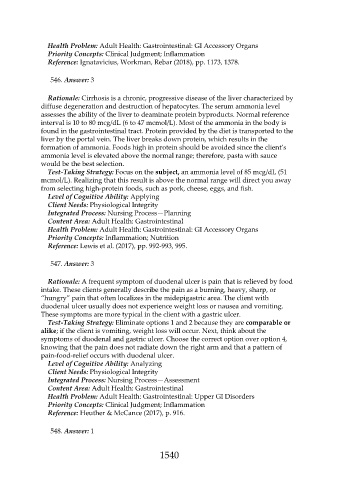Page 1540 - Saunders Comprehensive Review For NCLEX-RN
P. 1540
Health Problem: Adult Health: Gastrointestinal: GI Accessory Organs
Priority Concepts: Clinical Judgment; Inflammation
Reference: Ignatavicius, Workman, Rebar (2018), pp. 1173, 1378.
546. Answer: 3
Rationale: Cirrhosis is a chronic, progressive disease of the liver characterized by
diffuse degeneration and destruction of hepatocytes. The serum ammonia level
assesses the ability of the liver to deaminate protein byproducts. Normal reference
interval is 10 to 80 mcg/dL (6 to 47 mcmol/L). Most of the ammonia in the body is
found in the gastrointestinal tract. Protein provided by the diet is transported to the
liver by the portal vein. The liver breaks down protein, which results in the
formation of ammonia. Foods high in protein should be avoided since the client’s
ammonia level is elevated above the normal range; therefore, pasta with sauce
would be the best selection.
Test-Taking Strategy: Focus on the subject, an ammonia level of 85 mcg/dL (51
mcmol/L). Realizing that this result is above the normal range will direct you away
from selecting high-protein foods, such as pork, cheese, eggs, and fish.
Level of Cognitive Ability: Applying
Client Needs: Physiological Integrity
Integrated Process: Nursing Process—Planning
Content Area: Adult Health: Gastrointestinal
Health Problem: Adult Health: Gastrointestinal: GI Accessory Organs
Priority Concepts: Inflammation; Nutrition
Reference: Lewis et al. (2017), pp. 992-993, 995.
547. Answer: 3
Rationale: A frequent symptom of duodenal ulcer is pain that is relieved by food
intake. These clients generally describe the pain as a burning, heavy, sharp, or
“hungry” pain that often localizes in the midepigastric area. The client with
duodenal ulcer usually does not experience weight loss or nausea and vomiting.
These symptoms are more typical in the client with a gastric ulcer.
Test-Taking Strategy: Eliminate options 1 and 2 because they are comparable or
alike; if the client is vomiting, weight loss will occur. Next, think about the
symptoms of duodenal and gastric ulcer. Choose the correct option over option 4,
knowing that the pain does not radiate down the right arm and that a pattern of
pain-food-relief occurs with duodenal ulcer.
Level of Cognitive Ability: Analyzing
Client Needs: Physiological Integrity
Integrated Process: Nursing Process—Assessment
Content Area: Adult Health: Gastrointestinal
Health Problem: Adult Health: Gastrointestinal: Upper GI Disorders
Priority Concepts: Clinical Judgment; Inflammation
Reference: Heuther & McCance (2017), p. 916.
548. Answer: 1
1540

